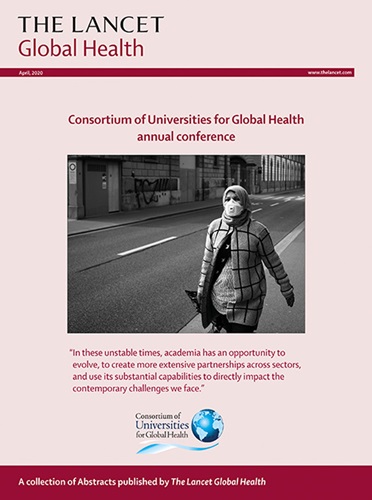印度糖尿病的流行、认识、治疗和控制:一项针对45岁及以上成年人的全国代表性调查。
IF 19.9
1区 医学
Q1 PUBLIC, ENVIRONMENTAL & OCCUPATIONAL HEALTH
引用次数: 0
摘要
印度是一个拥有14亿人口的国家,占全球糖尿病负担的很大一部分。鉴于糖尿病的风险随着年龄的增长而增加,临床和公共卫生干预措施可以预防糖尿病并发症,关于中老年人糖尿病流行状况的最新证据是必不可少的。我们的目的是估计45岁及以上印度人的全国代表性和州代表性样本中糖尿病的患病率、意识、治疗和控制。方法:我们在2017年至2019年期间对印度45岁及以上的成年人及其配偶进行了一项具有全国代表性的横断面调查。我们的样本包括来自36个邦和联邦属地的57 810个人及其配偶,反映了印度作为一个国家以及每个邦和联邦属地的代表性样本。参与者有糖化血红蛋白(HbA1c)测量的可用数据,以及糖尿病诊断、家庭经济状况和BMI等非缺失信息。年龄小于45岁的配偶被排除在分析之外。我们的主要结局是世界卫生组织推荐的糖尿病患病率和卫生服务指标。糖尿病患病率定义为自我报告既往糖尿病诊断或HbA1c为6.5%或更高的个体。现有数据不允许区分1型和2型糖尿病。糖尿病健康服务指标基于世卫组织推荐的四个核心指标:(1)在所有糖尿病患者中诊断出的比例(意识),在诊断出糖尿病的个体中,(2)血糖控制的比例(测量的HbA1c < 7.0%),(3)血压控制的比例(测量的血压<140/90 mm Hg),(4)自我报告使用降脂药物的比例。在全国样本中评估结果;按州和联邦领土划分;以及年龄、性别、农村与城市居住地区、教育程度、经济状况和体重指数等个人层面的特征。发现印度45岁及以上成年人的糖尿病患病率为19.8% (95% CI 19.4 - 20.2),总计5040万人(49.4 - 51.4)。男性和女性的患病率相似(男性19.6% [95% CI 19.0 ~ 20.2],女性20.1%[19.5 ~ 20.6])。城市糖尿病患病率(30.0% [95% CI 29.1 - 30.8])大约是农村患病率(15.0%[14.6 - 15.5])的两倍。经济发展水平较高的州往往具有更高的年龄标准化患病率(人均国内生产总值的标准化回归系数为0.65 [95% CI 0.45 - 0.85])。总体而言,60.1%(59.0 ~ 61.2)的人意识到自己患有糖尿病。在确诊的糖尿病患者中,45.7%(44.3 ~ 47.2)的患者血糖得到控制,58.9%(57.5 ~ 604)的患者血压得到控制,6.4%(5.8 ~ 7.2)的患者正在服用降脂药物。我们的研究结果强调,迫切需要扩大政策规模,以更好地预防、检测、管理和控制印度中老年糖尿病。FUNDINGUS国家老龄研究所;印度政府卫生和家庭福利部。本文章由计算机程序翻译,如有差异,请以英文原文为准。
Prevalence, awareness, treatment, and control of diabetes in India: a nationally representative survey of adults aged 45 years and older.
BACKGROUND
India is a country of 1·4 billion people that contributes to much of the global diabetes burden. Updated evidence on the state of the diabetes epidemic among middle-aged and older adults is imperative given that the risk of diabetes increases with age and that clinical and public health interventions can prevent diabetes complications. We aimed to estimate the prevalence, awareness, treatment, and control of diabetes in a nationally representative and state-representative sample of Indians aged 45 years and older.
METHODS
We conducted a cross-sectional, nationally representative survey of adults in India aged 45 years and older and their spouses from 2017 to 2019. Our sample included 57 810 individuals and their spouses from 36 states and union territories, reflecting a representative sample of India as a nation and of each state and union territory. Participants had available data on glycated haemoglobin (HbA1c) measurement and non-missing information on diabetes diagnosis, household economic status, and BMI. Spouses younger than 45 years were excluded from the analysis. Our primary outcomes were diabetes prevalence and health service indicators recommended by WHO. Diabetes prevalence was defined as individuals self-reporting a previous diabetes diagnosis or having HbA1c of 6·5% or higher. Available data did not allow the identification of type 1 versus type 2 diabetes. Diabetes health service indicators were based on four core metrics recommended by WHO: (1) proportion diagnosed out of all individuals with diabetes (awareness) and, out of individuals with diagnosed diabetes, (2) proportion with glycaemic control (measured HbA1c <7·0%), (3) proportion with blood pressure control (measured blood pressure <140/90 mm Hg), and (4) proportion self-reporting use of lipid-lowering medications. Outcomes were assessed in the national sample; by state and union territory; and across individual-level characteristics of age, sex, rural versus urban area of residence, education, economic status, and BMI.
FINDINGS
Diabetes prevalence among adults aged 45 years and older in India was 19·8% (95% CI 19·4-20·2), which amounted to 50·4 million people (49·4-51·4). Prevalence among men and women was similar (men, 19·6% [95% CI 19·0-20·2] and women, 20·1% [19·5-20·6]). Urban diabetes prevalence (30·0% [95% CI 29·1-30·8]) was approximately twice as high as rural prevalence (15·0% [14·6-15·5]). States with higher levels of economic development tended to have greater age-standardised prevalence (standardised regression coefficient for gross domestic product per capita 0·65 [95% CI 0·45-0·85]). Overall, 60·1% (59·0-61·2) of individuals were aware of their diabetes. Of individuals with diagnosed diabetes, 45·7% (44·3-47·2) achieved glycaemic control, 58·9% (57·5-60·4) achieved blood pressure control, and 6·4% (5·8-7·2) were taking a lipid-lowering medication.
INTERPRETATION
Our findings emphasise the urgent need to scale up policies to better prevent, detect, manage, and control diabetes among middle-aged and older adults in India.
FUNDING
US National Institute on Aging; Ministry of Health and Family Welfare, Government of India.
求助全文
通过发布文献求助,成功后即可免费获取论文全文。
去求助
来源期刊

Lancet Global Health
PUBLIC, ENVIRONMENTAL & OCCUPATIONAL HEALTH-
CiteScore
44.10
自引率
1.20%
发文量
763
审稿时长
10 weeks
期刊介绍:
The Lancet Global Health is an online publication that releases monthly open access (subscription-free) issues.Each issue includes original research, commentary, and correspondence.In addition to this, the publication also provides regular blog posts.
The main focus of The Lancet Global Health is on disadvantaged populations, which can include both entire economic regions and marginalized groups within prosperous nations.The publication prefers to cover topics related to reproductive, maternal, neonatal, child, and adolescent health; infectious diseases (including neglected tropical diseases); non-communicable diseases; mental health; the global health workforce; health systems; surgery; and health policy.
 求助内容:
求助内容: 应助结果提醒方式:
应助结果提醒方式:


